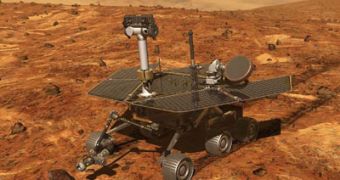Uncertainty hovers over Spirit, as it 'fights' for its 'life' on the surface of Mars, in order to reach the designated spot that would ensure its necessary power to remain operational over the coming Martian winter. To improve the chances that in the following winters the twin rovers, Spirit and Opportunity, would survive the severe drop in sunlight, NASA is currently developing a new software program that will find the best spots to send the vehicles during the cold season.
Crippled by multiple mechanical jams and devoided of sunlight by dust covering their solar panels, the two rovers will be helped in the future by software programs that will evaluate the potential risks of traveling towards certain locations on the surface of the Red Planet, and create a map of the best trajectory to follow.
Sent towards the northern end of the plateau called Home Plate, Spirit got caught in loose soil for about a week, thus reducing its chances of reaching the 25 degree slop that would provide the necessary sunlight to power it, meaning NASA will most probably stop the rover in its path and prepare it for the coming winter, which Spirit will spend mostly in stand by to save precious energy.
The preliminary results provided by the software program do not give the rover too many chances, in case it fails to complete the 120 meter journey to the northern end of the Home Plate, and furthermore, there is no place Spirit could take cover in the general area. As it cannot gather enough energy from the sunlight it receives, the vehicle must spend at least a day collecting energy and another one driving across the surface, thus even in ideal conditions it would still take a few days to reach a certain designated area.
By using images provided by the HiRISE instrument on board the Mars Reconnaissance Orbiter, the software program was able to determine several alternative safe paths that Spirit could follow in order to reach a safe spot that would provide shelter in case it does not reach the Von Braun slop. Similar programs have been used by NASA engineers to determine a safe path for the Opportunity rover, during its descent into the Victoria Crater which it had been franticly studying. However, they hope that they will succeed in creating a new program that would be used so that the rovers operate on their own, without human intervention.
Nevertheless, the 4 year old rovers will not be able to drive along the surface of the Red Planet forever, as they were originally designed to operate only for 90 days. To complement the potential loss of the twin vehicles, the European Space Agency initiated its own mission that is supposed to land a rover on the surface of Mars by the year 2013, in order to continue the study initiated by NASA.

 14 DAY TRIAL //
14 DAY TRIAL //